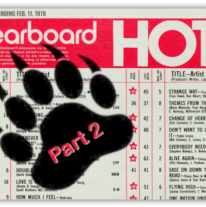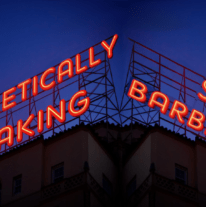Big Bands added slower tunes to their repertoire in the 1940s.
After all, you can’t Lindy Hop all night without a break or a heart attack.

Bands still played the upbeat dance numbers, but people like dancing cheek to cheek, too. Glenn Miller’s signature song “Moonlight Serenade” is the perfect example of a slow Swing song.
Miller wasn’t just a popular Swing star. He was one of the most popular musicians of the 20th Century. Depending on which chart of the day you use, he had more than fifteen #1s. Hits like “In The Mood,” “Pennsylvania 6-5000,” and “Chattanooga Choo-Choo” sold millions.

In his teenage years, Miller learned mandolin, cornet, and trombone. He missed his high school graduation and many college classes because he had out-of-town gigs, and eventually dropped out to play music professionally.
He was a trombonist for hire in Los Angeles and then New York City. But after realizing there were better trombone players, like Tommy Dorsey and Jack Teagarden, he concentrated on writing and arranging. He did a lot of arrangements for the Dorsey Brothers, and wrote four songs for them, before they angrily split up, with Jimmy leading the group on his own and Tommy taking over Joe Haymes’ band.
Miller started his own band in 1937 and it broke up two days into the following year. It just wasn’t different enough from other bands to make a name for itself.
Looking for his own sound, he arranged songs for a band with one clarinet, four saxes and muted trumpets. That made all the difference.
A mute is a device that changes the sound of a brass instrument and makes it somewhat quieter. The player sticks it into the horn’s bell and it stays in place with cork pads. There are a variety of shapes and each alters the sound in its own way.


Or the player can use a handheld mute, like a hat or the rubber part of a toilet plunger. These mutes can be moved while playing to produce a wah-wah sound, and can make the instrument sound like it’s talking.
The new Glenn Miller And His Orchestra had its first hit with “My Reverie,” its first top ten single with “Moonlight Serenade,” and its first #1 with “Wishing (Will Make It So).” Between 1939 and 1943, they had ten singles that sold over a million copies each.

Starting in December 1939, they had a thrice weekly, 15 minute radio program sponsored by Lorillard, the makers of Chesterfield cigarettes.
The Andrew Sisters sang with the Orchestra for the first year or so, later it was just Miller and the band.
Then, in 1942, the U.S. got involved in World War II after the Japanese bombed Pearl Harbor.
Many workers, including musicians, were drafted, but Miller was 38, too old for active service, so he volunteered to entertain the troops. Miller disbanded the Orchestra, gave his radio show to Harry James, and went off to become director of bands for the Army Air Forces Technical Training Command.

James and Miller had been competitors, but it was a friendly rivalry. They respected each others’ talents.
Miller couldn’t just walk away from his contract so he had to find a replacement who not only wouldn’t lose listeners, but might bring new ones. That would make Lorillard happy. He chose James, who was already known for his hits “You Made Me Love You (I Didn’t Want To Do It),” “All Or Nothing At All” with Frank Sinatra singing, and “Sleepy Lagoon.”
In 1944, Capt. Miller’s unit was transferred to England so he could broadcast to the troops in Europe.

The unit played over 800 concerts at American and other bases in England. General James Doolittle said that Miller’s band was a great morale booster, second only to letters from home.
Some of the broadcasts were meant for the German people, with Miller reading scripts written phonetically. Germany had their own propaganda, of course, broadcasting radio shows into the U.K.

An interesting example is Charlie And His Orchestra, an American-style Swing band led by Karl Schwedler, a German who spoke and sang in English. His pro-Germany lyrics threatened bombing civilians in England and were generally anti-semetic.
Now promoted to Major, Miller and his British cohort, Lt. Col. David Niven (yes, that David Niven) asked to move the unit to Paris to entertain troops on leave from the battlefields. Their request was approved, and Miller wanted to go to Paris to help speed stalled preparations.

He caught a ride with American Lt. Col. Norman Baessell and pilot John Stuart Morgan in a small, single engine plane on the afternoon of December 15, 1944. It was an unofficial flight.
The Battle Of The Bulge started the next morning, so it took a few days for anyone to notice the little plane with three people aboard never arrived.
No wreckage was found so it’s presumed that the plane went down in the English Channel. The official inquiry said it was a combination of engine failure, human error, and bad weather but there are many other theories as to what happened. One says that it was friendly fire, another says the official story is a cover up for him dying in a Paris brothel, and another that he faked his death and fled to South America.
There are more, because conspiracy theorists are going to theorize.

We may never know. The steel fuselage and engine may have lasted this long in salt water, but all attempts to find it at the bottom of the Channel have been unsuccessful.
War changes everything. Even music.
Even fashion. Consider the zoot suit.

Its jacket has big padded shoulders and very wide lapels. It can be long enough to reach the knees. The trousers are high waisted and baggy. Accessories might include a very long watch chain and a hat with a huge brim.
No one can take credit for designing the zoot suit. It just happened spontaneously in the 1930s. Young men would buy a suit two sizes too big and then tailor it to fit at the waist. That left a lot of fabric hanging loose.
We don’t really know where the zoot suit first appeared.

Some sociologists say it started becoming fashionable in black neighborhoods of New York, Chicago, and other northeastern cities.

It spread to the southwest and became popular with Hispanic men in Texas and southern California.
Others think it was the other way around, starting as a variation of a traditional costume from Pachuca, Mexico. Still others say it started in Florida and Georgia and spread north and west from there.
Whatever its origin, it first became popular with black and Hispanic men. Some Asians and Anglos took to wearing it, too.
While the zoot suit didn’t come from Swing, musicians took to wearing them on stage.

Cab Calloway, for instance, helped popularize it. The zoot suit was Swing-adjacent.
It’s a purely American style, and its wearers saw it as patriotic.

Detractors thought the tight waist made men look effeminate. However, those same critics also said that the women’s variation, a big, colorful jacket with a long skirt, wasn’t feminine at all.
As the country entered WWII, rationing was put in place.
Sugar, gasoline, metal, everything was directed to the war effort. Fabric, too.
Many Japanese-Americans were interned. And some Mexican-Americans were deported as security risks, despite some being citizens because they were born in the U.S. At the same time, agricultural and manufacturing workers were needed for the war effort.

Racial tensions were high.
In August of 1942, José Gallardo Díaz was found unconscious near a reservoir on the Los Angeles River. The reservoir was a popular hangout for Mexican-Americans and was nicknamed “Sleepy Lagoon,” after the Harry James song. Diaz died shortly after he was taken to the hospital.

Though the autopsy found Diaz was drunk and may have injured himself accidentally, seventeen young people were charged with his murder. Twelve were convicted.
In what became known as the “Sleepy Lagoon Murder” trial, the accused weren’t allowed to change their clothes and were forced to stand up for the jury to see that they were wearing zoot suits. Prosecutors said it was something only “hoodlums” wear.
In 1944, the ruling was overturned on appeal for lack of evidence. The judge, Charles W. Fricke, was found to have mishandled the case and his bias “materially injured” the defense. The damage to race relations, however, had already been done.

Between June 3rd and 8th, 1943, sailors stationed near Los Angeles took to attacking anyone wearing a zoot suit, saying that wasting so much fabric was un-American.
In some instances, the victims were teens or younger. Too young to defend themselves against a gang. They were stripped and beaten. All the victims were Mexican American or African American or Asian American. All the attackers were white.
It wasn’t about patriotism.
These attacks became known as the “Zoot Suit Riots” and later inspired a song of that name by the Oregon band Cherry Poppin’ Daddies.

That was in 1997 in the midst of an underground Swing revival that included bands like Squirrel Nut Zippers, Big Bad Voodoo Daddy, and Royal Crown Revue.
The Brian Setzer Orchestra hit #23 in 1998 with a cover of Louis Prima’s “Jump, Jive, and Wail.” Setzer, of course, had already led a Rockabilly revival in the 80s with his band Stray Cats. Rockabilly is more than a little influenced by Swing.
Revivals suggest that a genre has waned, and that began happening to Swing during WWII.
Glenn Miller’s death was not the end of Swing, but it was never the same. Not only was he gone but the public wanted something different after the war and, like it or not, Swing and WWII were inextricably linked. New styles came and went, in both music and clothing.

The zoot suit had probably run its course anyway, but after the war fashion went more clean cut, with classic tailoring for both men and women.
Christian Dior’s “New Look” featured sophistication instead of the zoot suit’s excess.
Likewise, the excess of a big band with two dozen players wasn’t appropriate anymore. Another contributing factor was the musicians strike of 1942. No union members recorded anything for two years.
The record labels got around this in two ways. First, they had a backlog of unreleased songs, and let them trickle into the market.
Second, since singers weren’t union members, they could be the “orchestra” behind a lead vocalist. An a capella group can’t swing like a big band, but this gave crooners a chance to fill the vacuum. Perry Como’s “Lili Marlene” and “You’ll Never Know” by Dick Haymes are good examples.
Interestingly, “All Or Nothing At All” hadn’t sold many copies when it was first released by Harry James And His Orchestra, with featured vocalist Frank Sinatra, but that was before Sinatra became widely known. When it was re-released during the strike credited to “Frank Sinatra with Harry James and his Orchestra,” it was a hit.

So after the war, the attention shifted from bandleaders to singers.
However, there was still a hankering for dance music.

A new genre called Jump Jive took Swing’s verve and brought it down to a small band of four to six players. It was a precursor of Rock & Roll.
Even so, Swing continues both in its original style.
Albums by Robbie Williams and Michael Bublé sell millions. And also in the form of Electro-Swing:

A recent genre that combines electronic production techniques and sampling with Swing’s beat, instruments, and danceability.
Not long after his disappearance, Miller’s family authorized the Glenn Miller Orchestra as a continuing enterprise.

Swing isn’t our most popular genre anymore, but it’s one of our longest-lived.
You’ll find Swing dances in every major city, and they usually start with lessons for newbies.
So get out there and dance.
Suggested Listening – Full YouTube Playlist:

Sing, Sing, Sing (With a Swing)
Louis Prima
1936

John Silver
Jimmy Dorsey And His Orchestra
1938

Jumping at the Woodside
Count Basie and his Orchestra
1938

Take The A Train
Duke Ellington And His Orchestra
1939

Moonlight Serenade
Glenn Miller
1939

T’Aint What You Do (It’s the Way That You Do It)
Jimmie Lunceford
1939

Jitterbug Jump
Frances Carroll And The Coquettes
1940

Moonglow
Artie Shaw
1941

Boogie Woogie Bugle Boy
The Andrews Sisters
1941

Hawaiian War Chant
Tommy Dorsey And His Orchestra
1942

Sleepy Lagoon
Harry James
1942

Let’s Go Bombing
Charlie And His Orchestra
1942

Jump, Jive and Wail
Brian Setzer Orchestra
1996

Zoot Suit Riot
Cherry Poppin’ Daddies
1997

Rock It For Me
Caravan Palace
2012
Let the author know that you liked their article with a “Green Thumb” Upvote!





As always, your series makes me feel smarter for having read it. I did not know the origins of the Zoot Suit Riots, so thanks for sharing that!
The diversion into WW2 with the Glenn Miller story was expected – though I wasn’t aware of the David Niven connection, the Paris brothel theory, or indeed the theory that he fled to South America – I suppose he changed sides and was Hitler’s private bandleader down in Argentina.
What was unexpected was the diversion into Nazi propaganda courtesy of Charlie & His Orchestra. Not sure I’ve ever heard a bigger disconnect than the swing sound and the jaunty delivery against the various atrocities described in the lyrics.
Then the story of the Zoot Suit Riots is as depressing and familiar in its own way. It can’t all be peace, love and understanding I guess.
On the positive side Cab Calloway does look amazing in his suit. Thanks for another immersive and informative episode!
And here, get your weekend started off right with some amazing Lindy Hop dancing!
https://youtu.be/qzc7vY9VTnk
Another fascinating article – thank you, Bill!
Deeper dive into the Zoot Suit Riots… disturbing to say the least.
https://youtu.be/nzgZBH0oiwQ?si=OkDzVn22W7bpq7OM
It’s a shame that just as quality audio recording became a reality (for instance, with Bing Crosby’s “White Christmas”, big band jazz was on its way out. I say this because one reason I don’t listen to big band as much is because I find the big blocks of brass rather aurally off-putting, yet that’s likely due to how the songs were recorded. There’s so much great stuff that deserves more attention. Then again, after listening to early 20’s jazz recordings, the 40s stuff sound like IMAX theater events!
The advent of vocal pop gave us some real ear candy, and some of the US’ best vocal standards…but it also eventually led to a lot of saccharine pap at the top of the charts. At the very least, that stuff provided a context for rock n roll to sound even more revolutionary, and necessary.
Love it, Bill! As always, I learned new things from you. Thanks for your research.